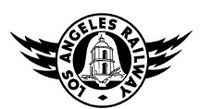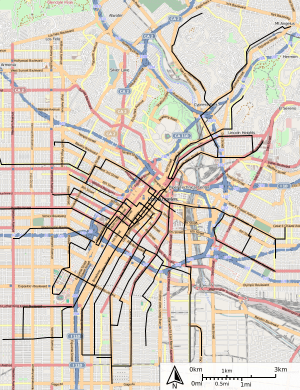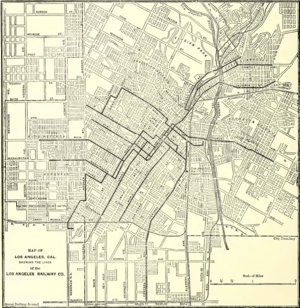Los Angeles Railway facts for kids
Quick facts for kids Los Angeles Electric Railway |
|||
|---|---|---|---|
 |
|||
| Info | |||
| Locale | Los Angeles, California and its suburbs | ||
| Transit type | Streetcar | ||
| Number of lines | 25 | ||
| Operation | |||
| Began operation | 1895 | ||
| Ended operation | 1958 (ceded to LAMTA) 1963 (rail operations ceased) |
||
| Operator(s) | Los Angeles Railway | ||
| Reporting marks | LARy | ||
| Technical | |||
| Track gauge | 3 ft 6 in (1,067 mm) | ||
| Electrification | 600 V DC overhead line | ||
|
|||
The Los Angeles Railway was a huge system of electric streetcars that helped people get around Central Los Angeles and nearby areas. It ran from 1895 until 1963. People often called these streetcars the Yellow Cars because of their bright color.
The Yellow Cars were different from the "Red Car" system run by Pacific Electric. The Yellow Cars offered frequent rides for shorter distances within the city. The Red Cars, on the other hand, were more for longer trips between cities, like a commuter train. Even though the Red Cars covered a bigger area, the Yellow Cars carried way more passengers every day!
These streetcars ran on special tracks that were 3 feet 6 inches wide. This is called a "narrow gauge" track. Sometimes, the Yellow Cars shared tracks with the Red Cars in downtown Los Angeles.
Contents
History of the Yellow Cars
How Los Angeles Got Its First Electric Streetcars
The very first electric railway in Los Angeles was built in 1887. It was created to help sell land on Pico Street. This early electric line used a simple system, but it closed after an accident at its power station.
At that time, Los Angeles also had "cable railways." These were like streetcars pulled by underground cables. They were very advanced for their time, but they were expensive to build and often had problems. New electric technology was quickly making them old-fashioned.
The Start of a Big Electric Railway System
In 1890, a man named Moses Sherman came to Los Angeles. He was a teacher who had become successful in business and railways. Sherman saw a chance to build a better electric transportation system. He teamed up with his brother-in-law, Eli P. Clark, and investors from San Francisco.
Sherman bought an old cable car line and decided to make it electric instead. He created a new company called the Los Angeles Consolidated Electric Railway Company (LACE) in November 1890.
Growing the Railway Network
Sherman and Clark worked very fast to expand the electric railway. In just one year, 1891, they did a lot:
- They bought the Depot Line, which went to the main train stations.
- They opened a new line on First Street, replacing an old cable car line.
- They turned another railway line on Central Avenue into an electric one.
- They built a new line to serve the University of Southern California and Agricultural Park.
- They also opened new lines on Maple Avenue and rebuilt the Pico Street line.

By 1893, LACE had bought out the Pacific Cable Railway. This made LACE the biggest streetcar company in Los Angeles, owning about 90% of all the lines!
New Ownership and Expansion
In 1895, the company faced some money problems. The people who owned the company's bonds took control. They created a new company called the Los Angeles Railway (LARy). This new company bought all of LACE's assets.
The new management quickly bought new streetcars. They also finished changing all the old horse-drawn and cable car lines into electric ones by June 1896.
In 1898, a very rich businessman named Henry E. Huntington bought the Los Angeles Railway. Under his ownership, the system grew even more. At its busiest, the Yellow Car system had over 20 streetcar lines and 1,250 trolleys. These lines ran through the heart of Los Angeles, connecting many neighborhoods like Crenshaw, West Adams, Leimert Park, and Boyle Heights.
The Decline of the Yellow Cars
In 1944, Huntington's family sold the system to a company called American City Lines, Inc. This company was part of a larger group called National City Lines. This group was known for buying transit systems across the country.
After the sale, the company was renamed Los Angeles Transit Lines. The new owners started to replace many streetcar lines with buses in the late 1940s and early 1950s.
The End of an Era
The last few Yellow Car lines were taken over by the Los Angeles Metropolitan Transit Authority (LAMTA) in 1958. This agency is now called Metro. LAMTA also took over the remaining Red Car lines.
LAMTA decided to stop all electric streetcar service. They replaced the last five streetcar lines and two electric trolley bus lines with diesel buses. The very last Yellow Car ran on March 31, 1963, marking the end of an important era for transportation in Los Angeles.
Yellow Car Routes
The Los Angeles Railway had many different routes, each with a letter or number. Here are some of the main ones:
- A Line – Went from Mid City to Echo Park.
- B Line – Connected Nevin to City Terrace.
- D Line – Traveled from Westlake to Skid Row.
- F Line – Ran from Athens to Boyle Heights.
- G Line – Went from Nevin to South Park.
- H Line – Connected South Los Angeles to East Hollywood.
- J Line – Traveled from Jefferson Park to Huntington Park.
- K Line – Went from Nevin to South Park.
- L Line – Connected East Hollywood to Mid-City.
- N Line – Ran from Koreatown to South Park.
- O Line – Went from South Los Angeles to Lincoln Heights.
- P Line – Connected Mid-City to City Terrace.
- R Line – Traveled from Hancock Park to East Los Angeles.
- S Line – Went from Watts to East Hollywood.
- U Line – Connected Nevin to West Adams.
- V Line – Ran from Nevin to East Hollywood.
- W Line – Went from Mid-City to Highland Park.
- 2 Line – Connected Echo Park to Montecito Heights.
- 3 Line – Traveled from Skid Row to Hollywood.
- 5 Line – Went from Hawthorne to Eagle Rock.
- 7 Line – Connected South Los Angeles to the Los Angeles Plaza Historic District.
- 8 Line – Ran from Leimert Park to the Los Angeles Plaza Historic District.
- 9 Line – Went from Leimert Park to the Wholesale District.
- 10 Line – Connected Leimert Park to Lincoln Heights.
The Streetcars Themselves
Starting in 1937, the Los Angeles Railway began buying newer, more modern streetcars called PCC streetcars. These were used on the busiest lines that couldn't easily be changed to bus routes.
After the streetcar service ended, many of the old cars were simply thrown away. However, in 1956, 41 of the Type H-4 cars were sent to Seoul and Pusan, South Korea as part of a help program.
Streetcar Colors
The Yellow Cars were famous for their bright yellow color. At first, they had two shades of yellow, with a lighter yellow roof. Later, a new design was used, which included a yellow body, a white roof, and a sea-foam green middle section. This was sometimes called the "fruit salad" scheme.








